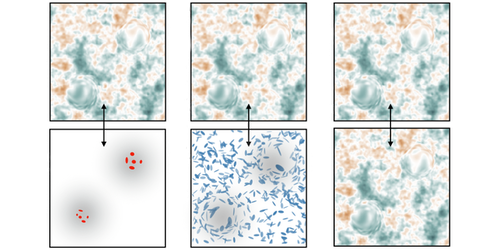Cosmological Parameters Improved by Combining Data
The so-called cosmological parameters describe the evolution of matter in the Universe and are used by scientists to describe properties of the Universe, including its rate of expansion and curvature. However, noise in the measurements used to determine these parameters can lead to uncertainty in the data and cause imprecise inferences of the parameters’ values. Now, the Dark Energy Survey (DES) Collaboration and the South Pole Telescope (SPT) Collaboration present updated constraints on key cosmological parameters, using a combined analysis of DES, SPT, and Planck satellite data [1–3]. The improved constraints provide a robust and consistent cross-check of previous DES results (see Synopsis: Dark Energy Survey Hits a Triple).
In the new analysis, the SPT Collaboration used Planck and SPT data to construct an updated map of the gravitational lensing of cosmic-microwave-background photons by massive cosmic structures. The team then cross-correlated the map data with that from DES measurements of the positions and shapes of galaxies, as well as the distribution of matter surrounding those galaxies. The analysis provided cosmological parameters with a smaller uncertainty than previous values.
Measurements taken with a single telescope can fall victim to systematic errors of that instrument, says Yuuki Omori, who works at the University of Chicago and is a member of both the DES and SPT collaborations. Measurements made with two telescopes can be combined to make data “more robust,” he says.
–Allison Gasparini
Allison Gasparini is a freelance science writer based in Santa Cruz, CA.
References
- Y. Omori et al. (DES and SPT Collaborations), “Joint analysis of Dark Energy Survey Year 3 data and CMB lensing from SPT and Planck. I. Construction of CMB lensing maps and modeling choices,” Phys. Rev. D 107, 023529 (2023).
- C. Chang et al. (DES and SPT Collaborations), “Joint analysis of Dark Energy Survey Year 3 data and CMB lensing from SPT and Planck. II. Cross-correlation measurements and cosmological constraints,” Phys. Rev. D 107, 023530 (2023).
- T. M. C. Abbott et al. (DES and SPT Collaborations), “Joint analysis of Dark Energy Survey Year 3 data and CMB lensing from SPT and Planck. III. Combined cosmological constraints,” Phys. Rev. D 107, 023531 (2023).




